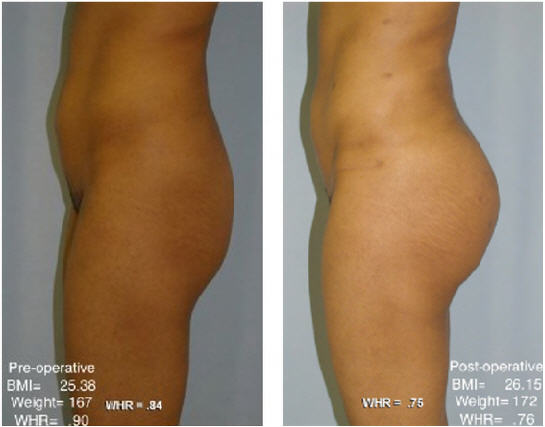Micro-fat grafting surgery involves removing fat from one part of the body and implanting it elsewhere. For instance, a woman could remove fat from her abdomen and have it added to the backside. Singh and Randall obtained pre- and post-operative pictures of the side or back views of 15 women that had undergone this procedure and had their attractiveness rated by men and women, one example of which is shown below(1, zip).
Fig 1. Pre- and post-operative pictures of a woman that underwent micro-fat grafting surgery. She was rated more attractive post-surgery in spite of having gained weight.
Some of these women had gained weight post-operatively while others had lost it, but all were rated as better looking after the surgery. Therefore, a reduction in waist-to-hip ratio (WHR) was shown to increase attractiveness independently of body mass. The limitation of this study was the absence of 3-D viewing and the fact that the skeletal structure was unaltered. A similar study using very realistic computer-generated 3-D models where skeletal structure is altered would help make a stronger case that WHR is related to attractiveness independently of body mass.
Reference
- Singh, D., and Randall, P. K., Beauty is in the eye of the plastic surgeon: Waist-hip ratio (WHR) and women's attractiveness, Personal Individ Diff, 43, 329 (2007).
Abstract: Attractiveness conveys reliable information about a woman’s age, health, and fertility. Body fat distribution, as measured by waist-to-hip ratio (WHR), is a reliable cue to a woman’s age, health, and fertility, and affects judgment of women’s attractiveness. WHR is positively correlated with overall body weight or body mass index (BMI). Some researchers have argued that BMI, rather than WHR, affects judgments of female attractiveness. To evaluate the role of WHR, independent of BMI, we secured photographs of pre- and post-operative women who have undergone micro-fat grafting surgery. In this surgery, surgeons harvest fat tissue from the waist region and implant it on the buttocks. Post-operatively, all women have a lower WHR but some gain weight whereas others lose body weight. Results indicate that participants judge post-operative photographs as more attractive than pre-operative photographs, independent of post-operative changes in body weight or BMI. These results indicate that WHR is a key feature of women’s attractiveness.
